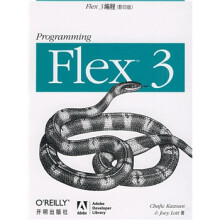Flex3编程(影印版)

Foreword
Preface
1. Introducing Flex
Understanding Flex Application Technologies
Using Flex Elements
Working with Data Services (Loading Data at Runtime)
The Differences Between Traditional and Flex Web Applicanons
Understanding How Flex Applications Work
Understanding Flex and Flash Authoring
Whats New in Flex 3
2. Building Applications with the Flex Framework
Using Flex Tool Sets
Creating Projects
Building Applications
Deploying Applications
3. MXML
Understanding MXML Syntax and Structure
Making MXML Interactive
4. ActionScript
Using ActionScript
MXML and ActionScript Correlations
Understanding ActionScript Syntax
Variables and Properties
Inheritance
Interfaces
Handling Events
Error Handling
Using XML
Reflection
5. Framework Fundamentals
Understanding How Flex Applications Are Structured
Loading and Initializing Flex Applications
Understanding the Component Life Cycles
Loading One Flex Application into Another Flex Application
Differentiating Between Flash Player and the Flex Framework
Caching the Framework
Understanding Application Domains
Localization
6. Managing Layout
Flex Layout Overview
Making Fluid Interfaces
Putting It All Together
7. Working with UI Components
Understanding UI Components
Buttons
Value Selectors
Text Components
List-Based Controls
Pop-Up Controls
Navigators
Control Bars
8. Customizing Application Appearance
Using Styles
Skinning Components
Customizing the Preloader
Themes
Runtime CSS
9. Application Components
The Importance of Application Components
MXML Component Basics
Component Styles
10. Framework Utilities and Advanced Component Concepts
Tool Tips
Pop Ups
Cursor Management
Drag-and-Drop
Customizing List-Based Controls
Focus Management and Keyboard Control
11. Working with Media
Overview
Adding Media
Working with the Different Media Types
12. Managing State
Creating States
Applying States
Defining States Based on Existing States
Adding and Removing Components
Setting Properties
Setting Styles
Setting Event Handlers
Using ActionScript to Define States
Managing Object Creation Policies (Preloading Objects)
Handling State Events
Understanding State Life Cycles
When to Use States
13. Using Effects and Transitions
Using Effects
Creating Custom Effects
Using Transitions
Creating Custom Transitions
14. Working with Data
Using Data Models
Data Binding
Enabling Data Binding for Custom Classes
Data Binding Examples
Building Data Binding Proxies
15. Validating and Formatting Data
Validating User Input
16. Client Data Communication
Local Connections
Persistent Data
Communicating with the Host Application
17. Remote Data Communication
Understanding Strategies for Data Communication
Working with Request/Response Data Communication
Web Services
Real-Time/Socket Connection
File Upload/Download
18. Application Oebugging
The Flash Debug Player
Using FDB
Debugging with Flex Builder
Remote Debugging
Logging Using trace() Within an Application
The Logging Framework
Debugging Remote Data
19. Building Custom Components
Component Framework Overview
Component Life Cycle
Component Implementation
Adding Custom Properties and Events
Adding Styling Support
20. Embedding Flex Applications in a Web Browser
Embedding a Flex Application in HTML
Integrating with Browser Buttons and Deep Linking
Flash Player Security
Using Runtime Shared Libraries
21. Building AIR Applications
Understanding AIR
Building AIR Applications
Working with AIR Features
Distributing AIR Applications
22. Building a Flex Application
Introducing the Sample Application
Utilizing Best Practices
Using Blueprints and Microarchitectures
Abstracting Common Patterns
Index
Preface
1. Introducing Flex
Understanding Flex Application Technologies
Using Flex Elements
Working with Data Services (Loading Data at Runtime)
The Differences Between Traditional and Flex Web Applicanons
Understanding How Flex Applications Work
Understanding Flex and Flash Authoring
Whats New in Flex 3
2. Building Applications with the Flex Framework
Using Flex Tool Sets
Creating Projects
Building Applications
Deploying Applications
3. MXML
Understanding MXML Syntax and Structure
Making MXML Interactive
4. ActionScript
Using ActionScript
MXML and ActionScript Correlations
Understanding ActionScript Syntax
Variables and Properties
Inheritance
Interfaces
Handling Events
Error Handling
Using XML
Reflection
5. Framework Fundamentals
Understanding How Flex Applications Are Structured
Loading and Initializing Flex Applications
Understanding the Component Life Cycles
Loading One Flex Application into Another Flex Application
Differentiating Between Flash Player and the Flex Framework
Caching the Framework
Understanding Application Domains
Localization
6. Managing Layout
Flex Layout Overview
Making Fluid Interfaces
Putting It All Together
7. Working with UI Components
Understanding UI Components
Buttons
Value Selectors
Text Components
List-Based Controls
Pop-Up Controls
Navigators
Control Bars
8. Customizing Application Appearance
Using Styles
Skinning Components
Customizing the Preloader
Themes
Runtime CSS
9. Application Components
The Importance of Application Components
MXML Component Basics
Component Styles
10. Framework Utilities and Advanced Component Concepts
Tool Tips
Pop Ups
Cursor Management
Drag-and-Drop
Customizing List-Based Controls
Focus Management and Keyboard Control
11. Working with Media
Overview
Adding Media
Working with the Different Media Types
12. Managing State
Creating States
Applying States
Defining States Based on Existing States
Adding and Removing Components
Setting Properties
Setting Styles
Setting Event Handlers
Using ActionScript to Define States
Managing Object Creation Policies (Preloading Objects)
Handling State Events
Understanding State Life Cycles
When to Use States
13. Using Effects and Transitions
Using Effects
Creating Custom Effects
Using Transitions
Creating Custom Transitions
14. Working with Data
Using Data Models
Data Binding
Enabling Data Binding for Custom Classes
Data Binding Examples
Building Data Binding Proxies
15. Validating and Formatting Data
Validating User Input
16. Client Data Communication
Local Connections
Persistent Data
Communicating with the Host Application
17. Remote Data Communication
Understanding Strategies for Data Communication
Working with Request/Response Data Communication
Web Services
Real-Time/Socket Connection
File Upload/Download
18. Application Oebugging
The Flash Debug Player
Using FDB
Debugging with Flex Builder
Remote Debugging
Logging Using trace() Within an Application
The Logging Framework
Debugging Remote Data
19. Building Custom Components
Component Framework Overview
Component Life Cycle
Component Implementation
Adding Custom Properties and Events
Adding Styling Support
20. Embedding Flex Applications in a Web Browser
Embedding a Flex Application in HTML
Integrating with Browser Buttons and Deep Linking
Flash Player Security
Using Runtime Shared Libraries
21. Building AIR Applications
Understanding AIR
Building AIR Applications
Working with AIR Features
Distributing AIR Applications
22. Building a Flex Application
Introducing the Sample Application
Utilizing Best Practices
Using Blueprints and Microarchitectures
Abstracting Common Patterns
Index
Chafic Kazoun是Atellis的创始人之一和首席软件架构师。从1998年开始他就使用Flash技术,并且在Flex面世伊始就开始使用这项技术。.
Joey Lott是Morphic Group的创办合伙人之一(www.themorphicgroup.com),该公司的专业领域就是Flex应用程序开发。Joey也写了很多其他关于Flex和Flash相关技术的主要书籍,包括OReilly的《ActionScript 3.0 Cookbook》。
Joey Lott是Morphic Group的创办合伙人之一(www.themorphicgroup.com),该公司的专业领域就是Flex应用程序开发。Joey也写了很多其他关于Flex和Flash相关技术的主要书籍,包括OReilly的《ActionScript 3.0 Cookbook》。
如果你想用Adobe Flex一试身手来创建富因特网应用程序(RIA),这是一本让你起步的理想书籍。《Flex 3编程》为帮助你理解Flex 3核心概念打下坚实的基础,并对如何、为何以及何时使用Flex的特定功能提供有价值的见解。难以计数的例子和实例代码演示了使用免费Flex开发工具包来构建完整实用的网络应用程序的方法。本书是Adobe公司的Flex 3参考文档的绝妙伴侣书。通过本书,你将学到:Flex框架内部的细节;使用MXML和ActionScript编程;用户界面组件的架构和布局;运用媒体元素的最佳实践方法;应用程序和组件的状态管理;关于使用变换和效果的锦囊妙计;调试Flex应用程序;在网络浏览器中嵌入Flex应用程序;为桌面构建AIR应用程序。
Flex 3使你置身于网络和桌面的富因特网应用程序革命的最前沿。《Flex 3编程》将帮助你从这项复杂强大的技术中获得最大的收益。
Flex 3使你置身于网络和桌面的富因特网应用程序革命的最前沿。《Flex 3编程》将帮助你从这项复杂强大的技术中获得最大的收益。
比价列表
公众号、微信群
 缺书网
缺书网微信公众号
 扫码进群
扫码进群实时获取购书优惠






